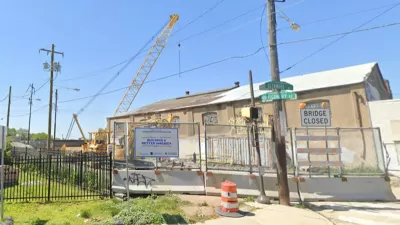Towns with shrinking or stagnant tax bases can't keep up with the costs of aging infrastructure without state and federal support.

Small cities around the country are struggling to pay for infrastructure projects, and as Jake Blumgart writes in Governing, many of them have "staggering" needs that they can't tackle without state and federal support, which lags far behind other countries–"only 2.4 percent American gross domestic product is applied to infrastructure, in comparison with 5 percent in the European Union and 9 percent in China."
"Advocates of increased infrastructure spending also note that before the 1980s there were greater federal commitments to at least some local projects. In the 1970s, the federal government paid to update many drinking and wastewater systems to bring them up to newly instituted environmental standards. But federal investments in water infrastructure fell during the 1980s." Today, cities with stagnant tax bases "can't [keep up with infrastructure needs] without vastly increasing their property tax revenues. If older cities just keep jacking the property tax rate up, that creates a vicious downward cycle where more population leaves," says Bill Fulton, director of the Kinder Institute for Urban Research at Rice University.
It isn't just Rust Belt cities feeling the pinch. "In many cases, more recently developed regions have leveraged population growth to get developers to build a lot of their necessary infrastructure. As a side effect, the consequences of the strict caps that states like California and Washington place on property tax increases were not felt. Today, however, population growth is slowing and developers are not on the hook to patch up the infrastructure they built decades ago. Property taxes revenues are not keeping up with regular expenditures, let alone expensive infrastructure investments." For mayors like Ferndale, Michigan's Melanie Piana, any new federal commitments to local infrastructure funding could inject much-needed capital into city coffers.
FULL STORY: Small Cities Can’t Manage the High Cost of Old Infrastructure

Trump Administration Could Effectively End Housing Voucher Program
Federal officials are eyeing major cuts to the Section 8 program that helps millions of low-income households pay rent.

Planetizen Federal Action Tracker
A weekly monitor of how Trump’s orders and actions are impacting planners and planning in America.

Canada vs. Kamala: Whose Liberal Housing Platform Comes Out on Top?
As Canada votes for a new Prime Minister, what can America learn from the leading liberal candidate of its neighbor to the north?

Wildlife Rebounds After the Eaton Fire
Following the devastation of the Eaton Fire, the return of wildlife and the regrowth of native plants are offering powerful signs of resilience and renewal.

LA to Replace Inglewood Light Rail Project With Bus Shuttles
LA Metro says the change is in response to community engagement and that the new design will be ready before the 2028 Olympic Games.

Paris Voters Approve More Car-Free Streets
Paris Mayor Anne Hidalgo says the city will develop a plan to close 500 streets to car traffic and add new bike and pedestrian infrastructure after a referendum on the proposal passed with 66 percent of the vote.
Urban Design for Planners 1: Software Tools
This six-course series explores essential urban design concepts using open source software and equips planners with the tools they need to participate fully in the urban design process.
Planning for Universal Design
Learn the tools for implementing Universal Design in planning regulations.
Central Transportation Planning Staff/Boston Region MPO
Heyer Gruel & Associates PA
Institute for Housing and Urban Development Studies (IHS)
City of Grandview
Harvard GSD Executive Education
Toledo-Lucas County Plan Commissions
Salt Lake City
NYU Wagner Graduate School of Public Service





























